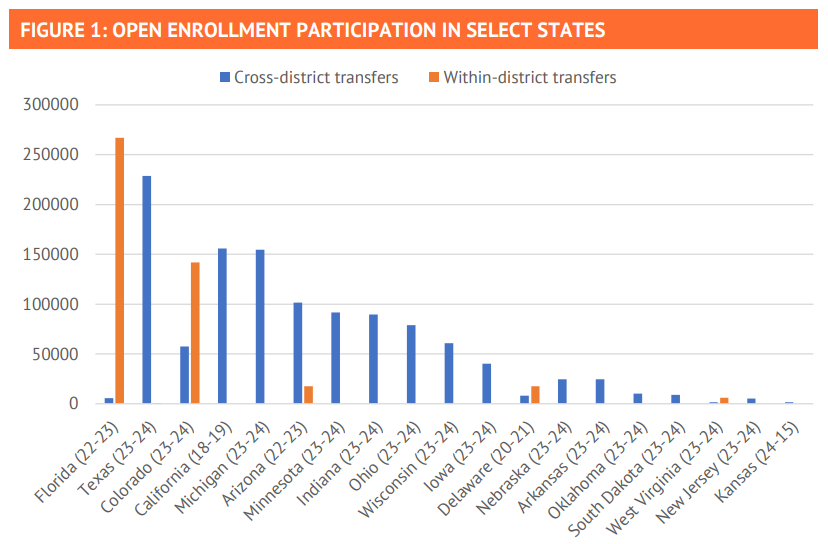by Erica Jedynak, chief operating officer, yes. every kid.
Families want more flexibility to direct their kids’ education, but what does this mean in practice? For many, it is simply accessing a public school that lies outside of their assigned boundary lines. Some call it “open enrollment,” but at its core, this idea is about empowering every student to access whichever public school in their state best meets their needs, and it’s gaining momentum around the country.
A new Reason Foundation report takes a look at this phenomenon, finding that last year, more than 1.6 million American kids across 19 states transferred to a different public school than the one to which they are residentially assigned. This means that, on average, one in 16 public school students in those states used open enrollment.
Colorado, Delaware, and Arizona have the highest participation rates, with 28%, 22%, and 14%, respectively, of public school students transferring to a public school beyond the one assigned by their family’s address. Minnesota and Michigan are not far behind.

Reason notes that 16 states structure their policies to guarantee families can apply to any public school in their state without unnecessary hurdles or boundaries holding them back. Among the strongest policies for empowering families are states like Idaho, Arkansas, and West Virginia, which prohibit discrimination based on residential address, ensuring that public schools are truly open to all.
Arizona has empowered students to apply to any public school for a generation, and the culture of schooling there has transformed to serve families, not bureaucracies. Arizonan and No More Lines Ambassador Sean McCarthy describes his view of this shift:
“To borrow from the famous John Green, a culture of school choice in Arizona happened slowly, then all at once. In the years following the 1994 reforms which authorized unlimited open enrollment and charter schools, it was a long slog. Yet some 30 years later, Arizona parents don’t tend to even mention which school boundary their house is in; it’s become mostly irrelevant. The evidence—enrollment growth, district adaptability, and changing real estate practices—is clear that a cultural transformation has taken place.
While Arizona families have enjoyed public education without boundaries, momentum is growing for this idea across the nation. Among the states making the biggest leaps forward this year, leaders in Arkansas and South Carolina put families first, empowering every student to enroll in any public school with available space, regardless of district boundaries.
Almost half of state legislatures considered expanding public school enrollment opportunities this year. From every region of the United States, from Alaska to Mississippi, to Illinois, Michigan, and New Hampshire, lawmakers from across the political spectrum introduced bills with the same goal: empowering families to enroll in the public school that works best for their kids’ needs.
For instance, a bipartisan coalition of leaders in Nevada came together to expand open enrollment by passing AB533, a bill that empowers families to apply to any public school in their district. This is a transformational change because 70% of Nevadans live in Clark County, home to the nation’s fifth-largest school district.
In short, state policymakers are beginning to see past the old divides of public-vs-private, rural-vs-urban, and red-vs-blue—and instead are seeing their mission to uplift every family with autonomy, freedom, and flexibility. The momentum to ensure public schools are available to all is unstoppable.
Interested in the movement for universal access to public schools? The No More Lines Coalition is a diverse group of more than 60 organizations with a goal to abolish exclusionary school boundary lines in every state by 2030.
